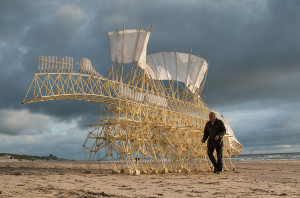
Motivation
As a future engineer taking Aesthetic of Design class, one of the first things that came in mind was the work of artist and physicist Theo Jansen. It all started in 1090 when he started building the Strandbeest and today he is one of the most recognized artists for his work.
Strandbeests are dynamically beautiful in a way that might get you thinking they are some sort of an engineering product. However, standing as big as 6m in length, 5 m in width, 4.7 m in height and weighing 3200 kg they are burly aesthetic and applicable to the up-cycling criteria. That is, first they were built out of wood but today they are built out of PVC, bottles and vinyl sheets. Almost mimicking animals at times, utilizing dynamics, wind and the beautiful scenery as they are mostly tested on beaches, they will fascinate you.
Absorbing
Being made to realize that engineering can be aesthetic, too, I wanted to understand Strandbeests’ dynamics in hope of building my own mini dynamic sculpture. Mini sculpture that aesthetically looks nice and functionally dynamic. Moving forward, I bought a mini strandbeest assembly kit to help me better understand the mechanism and drain some ideas, and I was able to assemble it as shown in the following figures:
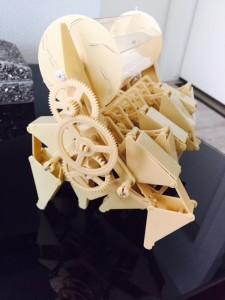
Side view showing gears connected to wind tunnel and crankshaft
![FullSizeRender[1]](https://www.aesdes.org/wp-content/uploads/2016/01/FullSizeRender1-225x300.jpg)
Front view of wind tunnel and legs
Playing around
My next step was finding my up-cycle materials. I obtained some used toys and LEGO, and went ahead and played with them having a rough idea of what I want, a dynamic toy. Few hours later I had generated few ideas regarding the design. The design would utilize gears and wheels and would probably look like a vehicle driven by a fan and the wind.
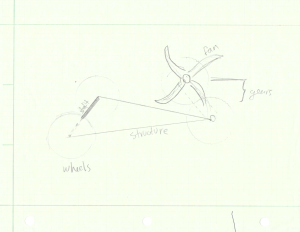
preliminary design sketch
Making a toy
Finally, I gathered what I wanted, two wheels, additional two wheels that I decided to use as gears and a little fan. However, trying to build sturdy structure proven to be somewhat difficult. What has become some sort of a vehicle now kept on falling on its sides. Another challenge was the friction on wheels and gears, ting them too tide to structure or using rubber or glue hindered the rotation of wheels. Nevertheless, after going through an iterative process whereby I refined my design over and over in terms of looks and materials I was finally able to build figure shown below which runs fine when I blow hair dryer air on its fan.
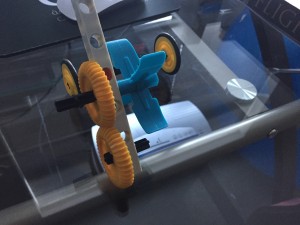
Final project built using old toys parts
Vision
In the near future I would like to take this project further and use a motor and a solar cell, which I’ve already obtained, to drive the mini toy dynamics. Furthermore, I would like very much to mimic a walking sort of motion thus I might 3D print gears and connect them to a shaft to establish this motion.
Last but not least
Finally, though I was aiming for the “motion” aesthetic my project ended having “LEGO” aesthetic to it, too. Nonetheless, I will continue on trying to improve on the “motion” aesthetic as I think that the walking motion is more attractive than sliding motion. Attached is the designing process I went and plan on going through as I develop my project.
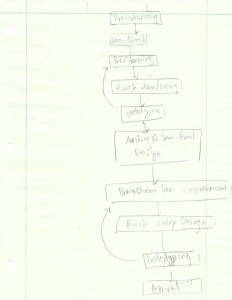

33 Comments. Leave new
What an ambitious project! Nice job putting so much thought into the mechanism. I can’t wait to see if you continue working on it.
I actually came really close to making one of these for my upcycling project. Really well done!
I like that you started the project by buying an actual mini strandbeest to get a better understanding of how they work. I think it will come in handy for the next iteration(s) of your final project. Good work!
Neat project. Have you let any kids play with this, is it robust enough? I think they’d love it if it is.
This is a really cool design. The strand beasts are an interesting mechanical creations that move like biological beings.
Wow. I am so impressed that this actually work. One thing that I was missing was a strong aesthetic from this project.
I really like your inspiration for this project. I would suggest to use a method other than wheels so that the object isn’t just being pushed. I feel like that would capture the aesthetic more clearly.
I was fascinated by your aesthetic exploration post and it’s cool to see ow you developed your own strandbeest. I thought some of the adaptions that the original designer made such as wind sails and multiple legs would have been cool to implement into your design– maybe for the next model. Great work
Really cool aesthetic, I like the use of Legos.
Do you have plans to build on your design by either making it bigger or adding more of the look of the strandbeest with wood or strings?
I haven’t seen strandbeest’s before, so I just did some poking around on the web. There are some really cool large scale projects, and I think you captured the aesthetic fairly well.
I love the design of the beach crawlers. It might be interesting to add more components that move.
I like how you went with a dynamic design for this project. It looks very free willed in the design which emphasizes the process of upcycling
Your project design influence is really cool. If you add more fan blades, it might help to increase the mobility of your project. I’d be excited to see how your project can advance when you add solar power to help drive the vehicle.
That is amazing. You could have probably used this for your final project. Using wind to power this device was well designed. It looks like a lot of fun to make and play with. Will you give it to a child or keep it for yourself?
Great mechanical project, really impressed with the end project. Awesome job!
Great Aesthetic. I feel this was one of the most challenging projects to understand and build. It would have been great to include the legs as legs and not as wheels. But still it looks more of a blend between animals and machinery, which is ironic because humans have been using animals as machines. Its great to hear that you are moving forward with this as a final project.
It turned out super cool. I really like the dynamic aesthetic of the project.
Nice job on learning from the strandbeest kit and recycling old toy parts.
Awesome! That’s a challenging task to take on, but yours turned out really well!
Great idea, a small start to something big I’m sure. Interesting to use old toys and wind to build a moving piece. Bright and fun for the eco toy crowd.
Really intricate stuff – cool that you were able to use the knowledge you gained from the kit to make your own! Impressive.
The inspiration for this project is awesome.
This is already really cool,but with the motor it will be walking consistently. well done
Really great project. I like the dynamics and the concept of the Strandbeest. I agree, would’ve liked to see more walking motion.
This is pretty cool and I love that you used old toys to create your project. I also think it makes sense that you looked at a previous kit example to inspire your own strandbeest that moved through air flow. Good job!
Good job making the strandbeest work. It certainly mixes that aesthetic with that of children’s toys.
When I first saw the image on the top. I didn’t realize understand what strandbeests were. After watching your presentation, they are really impressive and it was really smart of you to get that assembly kit to understand how they work!
I like how you played around with a kit to figure out how to build the project. It is an interesting approach. Do you have any plans on recreating the end result to fix the problems you saw or make a more complex strandbeest?
I’ve always found the strandbeests to be very interesting. I like that you were able to mimic the motion with common toys.
It would be really amazing to expand upon your current design for the next project! I love how you were able to make the design work and move with the wind/air!
Again, I really enjoy the strandbeest aesthetic. To recreate the archetypal strandbeest appearance but to a miniaturized scale is quite difficult and ambitious, so I am glad to see that you decided to use components from old toys instead. Using LEGOs is a fantastic way of generating pretotypes (quick and low resolution prototypes). To me, it looks like your goal for this upcycling project was to create a simple prototype for your final project. I can see why you would choose to use toy parts; It is easier to use pre-made gears and other mechanical parts when the goal is to create a working prototype. The downside, from my point of view, is that it is very difficult to recreate the artistic appeal of the strandbeest aesthetic. Personally, the strandbeests are beautiful because they look like machines invented by Leonardo da Vinci, who believed that science, engineering, and art are intertwined. If you decide to go forward with this project, I would strongly encourage you to think about and plan out how you want your strandbeest to demonstrate that blend of disciplines. Overall, good work!
Anfal,
This is stunning choice of an aesthetic. I first saw it on your aesthetics exploration post. I was really impressed by the way the Strandbeest moves by wind. I am really digging the design that the Jansen has. Thanks for giving credit to your inspiration, it’s important to be clear about that. There is a great deal of aesthetics in your project and I am sure you will have a lot of room for innovation and improving on the design. I am glad you recognize the challenges of your project in general especially on the smaller scale you are attempting to build it. Since you are facing a great deal of challenges and a tight timeline. I would highly encourage you (after consulting with professor Hertzberg) to move forward with this project as a final project as well since it satisfies the “Dynamic” requirement. For a continuation of this project you might want to look at straws for the body and the legs. They are structurally sound and can be moved easily by wind. For the attachment you might want to have paperclips or tooth picks. I understand that you might have an idea of what you are going to do in the next project, but I was just throwing the last suggestions out there if you were still thinking about it. Excellent aesthetic and great job on building your own 🙂